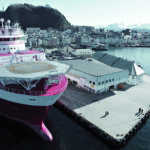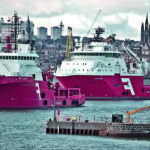Aalesund-based Farstad is one of the world’s leading offshore operators. Most of its 56-ship fleet is deployed on long-term deals with prominent charterers and the company’s senior executives are pleased that its fleet expansion programme has come to an end just as the market faces the challenge of absorbing hundreds of new anchor handlers and other offshore support vessels which aren’t yet needed.
Earlier this year, Farstad took delivery of the most powerful offshore vessel built to date. The March delivery of the[ds_preview] »Far Samson« from STX Norway Offshore AS-Langsten, signified an important step for the company. The multi-function plough, tug, supply, subsea service vessel marks Farstad’s arrival in this sector of the offshore market. During tests, the vessel set a record, with a continuous bollard pull, verified by DNV, of 423 t. This will enable her to pull a plough of around 200 t in water depths of up to 1,000 m.
The vessel’s design, developed jointly by Farstad, the charterer (whose identity Farstad will not confirm) Saipem UK Ltd and Rolls Royce Marine, was based on experience gained in the operation of another vessel in the Farstad fleet. The »Far Sovereign«, also built at the Langsten yard, has carried out trenching work for the last ten years and was, in fact, the first vessel capable of undertaking such operations autonomously. Prior to her arrival, trenching work was carried out by a barge, towed by two or more anchor handlers. The »Far Sovereign«, a UT 741 design, has a bollard pull of 280 t, enabling her to cut trenches of up to 1.5 m in water depths ranging to 500 m.
The »Far Samson«, however, a UT 761 CD design, takes offshore vessel construction a stage further. The 121.5-metre vessel has a beam of 26 m and a gross tonnage of 15,620. Her hull has been optimised for transit speeds in the range 12–17 knots and is strengthened to Ice Class 1B. The hull design incorporates a bulbous bow and special stern sections the lines of which ensure a clear flow of water to the propellers.
She has a relatively large draft of more than eight metres to provide sufficient immersion for large propellers, which are themselves necessary to achieve such high bollard pulls. She also has DeIce class for operation in icy waters and hostile conditions. Her Kongsberg Maritime K-POS 21 DP III system has been designed specifically with ploughing operations in mind. She has a dedicated ploughing mode which is also used in routine towing operations.
Farstad has invested some Nkr 80 m of the Nkr 900 m ($ 160 m) vessel price in environmental features that make her one of the greenest vessels in this sector. Such features include a catalytic reduction system for NOx emissions and, built to DNV’s Clean Design notation, a range of environmental features internally and externally and first-rate safety and living conditions for the crew. Her full notation is DNV + 1A1, Supply Vessel Basic, Tug, Clean Design, EO, SF DynPos AUTR, Comf-V(3) – C(3), Heldk-SH, NAUT OSV A, TMON, BIS, DK(+), Crane, Ice 1B (Hull only), DeIce.
The vessel carries two hydraulically-operated plough transportation systems, manufactured by Axtech Molde, which can be moved around the working deck both in and out of reach of the A-frame. The ploughs can be changed at sea, thereby saving valuable time as compared with earlier vessels which had to return to port to swap ploughs. Both units can be carried on deck in fully operational condition at all times. When not needed, however, the main plough can be sheltered under cover in a large detachable hangar on deck. On a charter where the main plough is definitely not required, therefore, it can be housed ashore in the hangar.
The A-frame itself, also designed and built by Axtech, is on the main deck and has twin cylinder systems on each side. A plough stabilisation frame is located just below the top of the A-frame and its winch incorporates active heave compensation to assist in the safe operation of the ploughs. Active heave compensation also counters the effects of waves when the vessel is deployed on subsea construction and, with the assistance of the ship’s dynamic positioning (DP III) system, she is sufficiently stable to continue the servicing off subsea installations even in rough weather conditions.
The A-frame facilitates work in water depths of up to 1,500 m but for greater depths, the main crane wire and the winch can also be integrated with the A-frame to enable operation in water depths of up to 3,500 m.
In fact, her sea-keeping, speed and bollard pull capabilities were extensively model-tested at Marintek in Trondheim, Norway. And her compliance with DP »hardware in the loop« (HIL) rules, designed to ensure fail-safe DP operations, required extensive tests and class approval of DP software functions at Marine Cybernetics, also in Trondheim.
The »Far Samson«’s ROV hangars to port and starboard are equipped with two Sepro Stavanger launch and recovery systems. Control rooms, workshops and ROV stores are also located in the hangar.
The vessel’s hybrid propulsion system combines diesel-electric and diesel mechanical transmission and is designed for maximum efficiency, flexibility and minimum emissions. She has two engine rooms divided by a longitudinal watertight bulkhead, a maximum speed of 19 knots and a maximum output from each of her two propellers of 12,000 kW.
The propulsion system consists of four Bergen B32:40 V 12P diesel engines, each of 6,000 kW, four AVK generators, two Kamewa Ulstein propeller plants and two Scana Volda gears, twin-in-single-out with power take-off and power take-in. A bollard pull of 150 t can be achieved, with 6,000 kW of output, when the vessel is using diesel electric machinery.
Altogether, the vessel has six thrusters to provide good station-keeping performance. They consist of one Ulstein Aquamaster swing-up azimuth thrusters, one Ulstein Aquamaster combi tunnel/azimuth unit and one Kamewa Ulstein thrusters, all forward and all of 1,800 kW each. Aft, there are three more units comprising one Ulstein Aquamaster swing-up azimuth thrusters of 1,800 kW and two Kamewa Ulstein tunnel thrusters of 1,200 kW each.
All of the tunnel thrusters are fixed pitch, variable speed whilst the swing-up units are controllable pitch, variable speed for improved fuel consumption. ABB Ulsteinvik designed and built the variable speed electric drive system for each propeller.
Other machinery includes four Bergen auxiliary engines, each producing 2,755 kW, and two AVK shaft generators with output of 4,000 kW each. The steering gear was supplied by Tenfjord; the Selective Catalytic Reduction system came from H + H Umwelt- und Industrietechnik in Germany (see below); and ABB supplied frequency converters and transformers. Other suppliers include Acon, Alfa Laval, Autronica, Enwa, Ing. Per Gjerdrum, Pyro and STX Norway Electro.
Up to 100 personnel on board are accommodated in 22 single and 39 double cabins to DNV’s highest Comfort class (V3)(C3) rules. Facilities include messes, a cafeteria, day rooms, a hospital, offices and conference rooms, spread over six accommodation decks.
The two-deck bridge arrangement features a semi-circular front-facing transit and navigation bridge with a client/ROV service area located in the centre. On the lower bridge, deck, which faces aft, a second set of consoles looks over the working deck.
The »Far Samson« is understood to be chartered to Saipem on a five-year service contract, with options.
German emissions equipment on board »Far Samson«
State-of-the-art NOx emissions reduction equipment from Germany’s H + H Umwelt- und Industrietechnik (H + H) is an essential component in making the »Far Samson« one of the greenest of the offshore sector’s latest- generation vessels. Although world leaders gathering in Copenhagen are focusing primarily on CO2 emissions, NOx emissions from diesel engines are also a growing concern. Unfortunately for shipping, marine diesels tend to kick out large volumes of NOx because poor fuel means high combustion temperatures which, in turn, generate more NOx.
Some of the measures introduced by engine builders recently to restrict NOx formation involve internal modifications to marine engines, including exhaust gas recirculation, water injection or the creation of a fuel-water emulsion. However, selective catalytic reduction (SCR) works as a result of the reaction between NOx and urea-based ammonia (NH3), producing harmless N2 and water vapour.
Ships with SCR units on board, such as the »Far Samson«, usually receive deliveries of urea as a 40 % solution by road tanker. The product is not poisonous and is relatively safe to transport. Commenting on the »Far Samson« installation, H + H MD Mr Michael Heck said the ship’s SCR unit was a »closed loop« system comprising four catalyst-converter housings, four static mixers and four high efficiency dosing panels for injecting urea into each of the four Rolls-Royce engines. With such a system, he said, ship operators could already meet IMO Tier 3 emissions levels well ahead of time.
Paul Bartlett




















